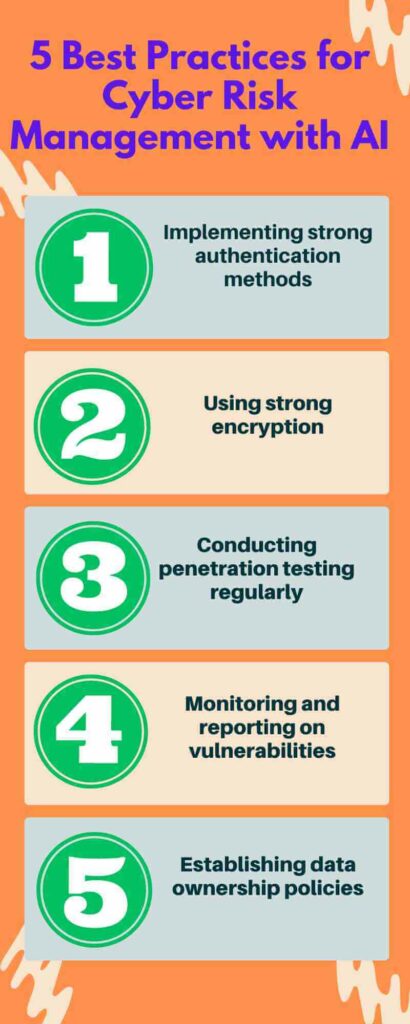Machine learning is a type of artificial intelligence that uses algorithms and statistical analysis to learn from data. It can be used to protect your cybersecurity by identifying patterns in data, anomalies and threats.
With machine learning, you can identify the patterns in your data, which are then used to create a model that helps you predict future events like cyber attacks.
This model helps you create more effective protection strategies for your company’s cybersecurity.
Some of the use cases of Machine Learning include: –
- Identifying anomalous behavior in network traffic to identify potential threats like botnet attacks or DDoS attacks –
- Identifying suspicious behavior on social media platforms like Facebook, Twitter and Instagram.
Detecting emerging threats for mobile devices AI uses machine learning to make predictions on what will happen in the future.
It was created by Alan Turing, the man widely credited for inventing computer science and artificial intelligence.
AI has made big strides in recent years with human-like capabilities like robotics, language translation, and facial recognition.
Cybersecurity is also used by Artificial Intelligence systems to be more effective in their protection. AI can detect malware, spam, phishing scams and online fraud.
Table of Contents
An Introduction to Machine Learning and AI in Cybersecurity
Cybersecurity is one of the most challenging and complex fields in the world. It is becoming increasingly difficult to keep up with the latest trends and threats, especially when it comes to cyber-attacks.
The rise of Artificial Intelligence in Cybersecurity has helped in making this field more manageable. With ML and AI, cyber security experts can identify patterns and anomalies that might lead to a cyber attack.
Machine Learning is a branch of Artificial Intelligence that uses algorithms to make decisions or predictions without being explicitly programmed.
Machine learning algorithms can help detect malicious behavior as well as protect networks from attacks.
It’s an automated process that learns from data sets without any human intervention.
Machine learning helps companies like Google, Amazon, Facebook, Twitter etc., make better business decisions by using predictive analytics and it helps organizations to make better decisions by using predictive analytics.
Machine learning is a great tool that can help in cybersecurity. Machine Learning Algorithm is a reusable computational process that transforms data into actions and makes predictions based on the training data.
ML algorithms are constantly trained on new sets of data to excel at making predictions or decisions without being explicitly programmed.
Best Practices for Cyber Risk Management with AI
Cyber risk management is a difficult task for any organization. It is important to take precautions in order to prevent any kind of security breach and gain an advantage over the competition.
Security should be a priority when using AI in the workplace or anywhere else. This can be achieved by following these best practices: –
- Implementing strong authentication methods
- Using strong encryption
- Conducting penetration testing regularly
- Monitoring and reporting on vulnerabilities
- Establishing data ownership policies.

Risk mitigation is essential for any organization that uses AI. The risk mitigation plan must be well-planned in order to minimize the risks and minimize any potential damages from a security breach.
How will AI and machine learning affect cybersecurity?
AI and machine learning are becoming more prevalent in the workplace. Recently, cybersecurity experts have expressed concerns about the future of AI and machine learning, especially as they relate to cybersecurity.
Experts believe that AI and machine learning will lead to a decrease in human-focused work overtime. , and many of the jobs associated with cybersecurity will be automated.
Artificial Intelligence can be used for tasks that are repetitive, time-consuming and predictable.
Cybersecurity is a field with a lot of elements that lend themselves to automation, such as pattern recognition and scanning large volumes.
In addition, AI technology can potentially increase the efficiency of cybersecurity by allowing more information and data to be examined without human effort.
In recent years, the field of cybersecurity has steadily increased in demand. There are currently 17 million open cybersecurity jobs globally and this number is projected to grow to 23 million by 2021.
This rise in demand for job vacancies is due to technological advancements and the increasing number of people using technology that have made cybersecurity a pervasive concern.
The human-focused cyber security field is predicted to suffer the most from the automation of this field.
A study published by NCBI in 2018 found that up to 50% of human-focused jobs in cyber security could be replaced by AI technology by 2030.
The primary uses of AI cybersecurity technology are:
- Applying automation for detection, classification, and response to cyber intrusions using unmanned systems;
- Modeling and understanding the behavior of users so that malicious activity can be detected, and
- Data analytics to detect abnormal behavior and unusual patterns which may indicate a cyber attack.
Future of AI in Cybersecurity
Artificial intelligence is becoming more and more popular in the cyber security industry. AI-based solutions are used to detect threats, prevent attacks, and identify vulnerabilities.
AI-based solutions are also used to create cybersecurity policies, increase the efficiency of incident response, and improve the overall cybersecurity culture.
Some of these AI solutions include:
- Machine-learning algorithms that find patterns in data
- Predictive analytics that analyzes data to predict future events
- Automated threat detection systems that detect abnormal behavior
- Anomaly detection systems look for unusual activity on a network or system and
- Artificial intelligence agents (AIAs) make decisions based on information from sensors or human input.
The AI solution will be used by many organizations over the next few years.
- To improve customer service by enabling automated interactions with customers
- Facilitate and improve workflows,
- Processes and decision-making through automation
- Automatically detect incidents and
- Analyze data to improve security.
Algorithms used for AI are not just limited to computers. In recent years, many algorithms have been created for human use as well. These include: –
- Deep neural networks (DNN) are responsible for facial recognition. It is an interconnected group of nodes (i.e., artificial neurons) that process data via learning algorithms and connections between nodes with various processing layers.
- Neural machine translation (NMT), allows computers to translate text or speech in one language into another.
It is designed to model the way in which human brains process information, and it is used in some AI applications such as –
- Image recognition
- Speech recognition
- Natural language processing (NLP), and
- Machine translation.
Why is Artificial Intelligence Good For Cybersecurity?
AI has been a part of the cyber security industry for a long time. It has been used in various ways – from identifying malicious software to preventing cyber attacks.
AI is good for cyber security because it can be used to identify and prevent the following: –
- Cybercrime detection
- Malicious software identification and prevention
- Data breaches prevention
- Threat evaluation
- Data validation
Artificial Intelligence can be used to identify and prevent cybercrime such as
- Identity theft
- Financial fraud
- Business email compromise (BEC)
- Phishing AI can be used to prevent cyberattacks.
Malicious software typically has the ability to cause harm and AI can be used to identify and prevent malicious software from causing harm.
Cyber attacks can be prevented by using AI in the following ways:-
- Preventing malware
- Preventing hacks
- Defending online resources
AI is good for cybersecurity because it can be used to find and prevent digital threats.



